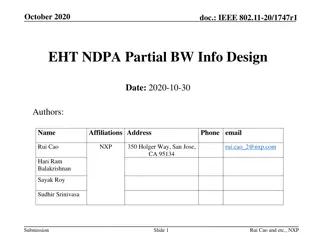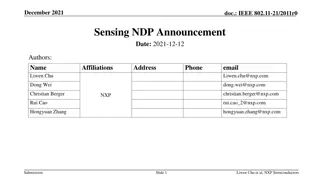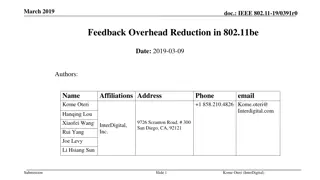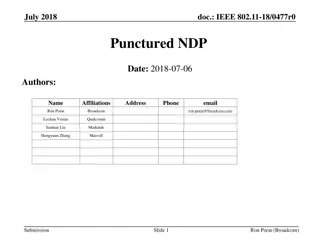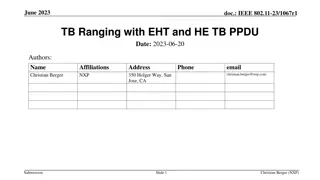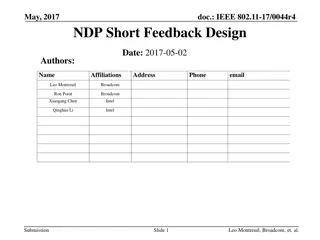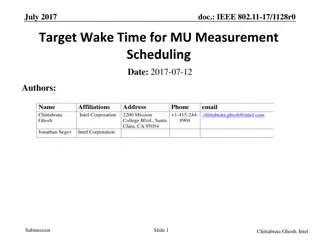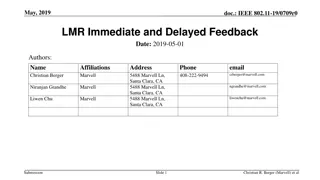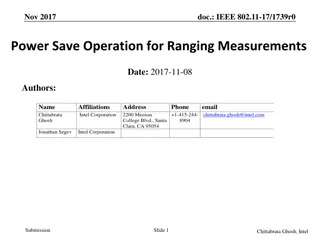IEEE 802.11-17/0044 NDP Short Feedback Design
The document discusses the need for short simultaneous feedback from multiple STAs in IEEE 802.11 systems for improved efficiency. It introduces the NDP feedback mechanism and proposes a signaling technique to efficiently collect feedback from a high number of STAs. The mechanism involves UL MU transmission in response to a trigger frame using orthogonal allocations to avoid collisions and transmit feedback without data payloads. By defining orthogonal allocations and utilizing frequency dimensions, the proposal aims to enhance system and power efficiencies in dense environments.
Uploaded on Sep 29, 2024 | 0 Views
Download Presentation

Please find below an Image/Link to download the presentation.
The content on the website is provided AS IS for your information and personal use only. It may not be sold, licensed, or shared on other websites without obtaining consent from the author. Download presentation by click this link. If you encounter any issues during the download, it is possible that the publisher has removed the file from their server.
E N D
Presentation Transcript
January, 2017 doc.: IEEE 802.11-17/0044 NDP Short Feedback Design Date: 2017-01-15 Authors: Name Affiliations Address Phone email Leo Montreuil Broadcom Ron Porat Xiaogang Chen Broadcom Intel Qinghua Li Intel Submission Slide 1 Leo Montreuil, Broadcom, et. al.
January, 2017 doc.: IEEE 802.11-17/0044 Background (1) It is well accepted that being able to get a very short simultaneous feedback from a high number of STAs (all STAs) improve the 11ax system and power efficiencies [1], [3] Many feedbacks require 1 bit: PS-Poll (power efficiency), Channel Availability (collisions avoidance) Other feedbacks could be 2 bit. For example: How many buffered Bytes for transmission: 0, 1 to 1000, 1000 to 5000, > 5000 ? A short simultaneous resource request feedback (1 or several bits) capable of supporting a high number of STAs is needed for an efficient UL MU simultaneous scheduling in addition to the existing (or enhanced) piggybacked buffer information Less overhead for resource request feedback than polling method Low and stable latency for resource request feedback, compared to possibly high and unpredictable latency with CSMA-CA in dense environments Submission Slide 2 Leo Montreuil, Broadcom, et. al.
January, 2017 doc.: IEEE 802.11-17/0044 Background (2) In Nov. 2016, added subclause 25.5.2.7 to the spec: 25.5.2.7 NDP feedback report procedure The NDP feedback report is a mechanism for an HE AP to collect short feedbacks from a very high number of HE STAs, in an efficient manner. The feedbacks (e.g. resource requests) are sent without data payloads in response to a Trigger frame. The feedbacks are not for channel sounding. This mechanism is optional for non-AP STA. But details of the NDP feedback mechanism are TBD This contribution propose a signaling technique for the NDP feedback mechanism that can handle a high number of STAs and is power and air time efficient Submission Slide 3 Leo Montreuil, Broadcom, et. al.
January, 2017 doc.: IEEE 802.11-17/0044 How to define the NDP feedback mechanism? UL MU transmission in response to a trigger frame Use frequency dimension for many small orthogonal allocations To avoid collisions, assign orthogonal allocations to users No data payload (NDP), STAs transmit energy on one orthogonal allocation for feedback with spreading gain in time domain for PHY robustness For minimal changes to the current PHY, we propose to use UL MU NDP simultaneous transmissions in response to a trigger frame and to define orthogonal allocations (resource block RBs) to multiplex different STAs feedbacks These orthogonal allocations (RBs) are defined by using different frequency tone sets Submission Slide 4 Leo Montreuil, Broadcom, et. al.
January, 2017 Overview of proposed signaling for Short Feedback doc.: IEEE 802.11-17/0044 There are 9 RUs of 26 tones in 20 MHz. Each 26 tones RU are sub-divided into four sets of 6 tones. 6 tones sets are chosen to pack 2 users per 26 tones RU 6 tones sets have enough frequency diversity per 26 tones RU One or two bit are assigned to one user feedback response Two sets of 6 tones are used to transmit 1 bit Channel estimation is not needed for detection AP and STAs must have a prior agreement on tone sets and P-matrix spreading to use for a given response Submission Slide 5 Leo Montreuil, Broadcom, et. al.
January, 2017 doc.: IEEE 802.11-17/0044 4 tones sets per RU-26 for UL Feedback 4X HE-LTF Tones transmitted Left or Right of DC Tone Set # Centered on DC All RUs, except RU centered at DC -15:4:-7, 4:4:12 -13:4:-5, 6:4:14 -14:4:-6, 5:4:13 -12:4:-4, 7:4:15 1 1:4:21 2 3:4:23 RU centered at DC 3 2:4:22 6 tones: 3.51 dB PAPR 5.21 dB 12 tones: 4.42 dB PAPR 6.87 dB 4 4:4:24 Notes: Dots represent unallocated tones For all RU-26 except DC, offset count is from leftmost tone. For RU-26 at DC, offset count is from DC. Submission Slide 6 Leo Montreuil, Broadcom, et. al.
January, 2017 doc.: IEEE 802.11-17/0044 Proposed feedback schemes Time Two sets of 6 tones are used to transmit 1 bit: If bx = 1, send energy on first tone set and quiet on second tone set If bx = 0, send energy on second tone set and quiet on first tone set Frequency STA1/State0 STA1/State1 STA 2/State0 STA 2/State1 STA3/State0 Tone set 1 STA3/State1 Tone set 2 STA4/State0 Tone set 3 STA4/State1 Tone set 4 Multiplex different users with P-matrix code (and potentially different tone sets); Separate different states of the same user with different tone sets. Submission Slide 7 Leo Montreuil, Broadcom, et. al.
January, 2017 Max # of STAs that can simultaneously send the UL Short Feedback doc.: IEEE 802.11-17/0044 Response = 1 bit Nss = 1 Nss = 2 Nss = 4 Nss = 1 Nss = 2 Nss = 4 18 36 72 36 72 144 74 148 296 148 296 592 Response = 2 bit BW 20 MHz 40 MHz 80 MHz 160 MHz 9 18 36 74 148 36 72 148 296 18 37 74 Submission Slide 8 Leo Montreuil, Broadcom, et. al.
January, 2017 doc.: IEEE 802.11-17/0044 Further discussion on the proposed feedback mechanism (1) Reuses the 4X HE-LTF sequence [2] Puncture all tones except for one or two 6 tones set in one 26 tones RU For a constant nominal power in each 26 tones RU, boost tone power relative to the target RSSI 10*log10(26/6) = 6.37 dB above target RSSI 12 tones: 10*log10(26/12) = 3.36 dB above target RSSI Multiply the punctured HE-LTF sequence by the P-matrix row corresponding to a specific spatial stream (SS) Allow multiplexing multiple users Recommend using 1x1, 2x2 and 4x4 P-matrix, 1 Nss 4 Corresponding to 1, 2 or 4 time-domain symbols Submission Slide 9 Leo Montreuil, Broadcom, et. al.
January, 2017 doc.: IEEE 802.11-17/0044 Further discussion on the proposed feedback mechanism (2) Spreading gain from SS improve performance and reliability: One symbol, Nss = 1 1x1 P-matrix Two symbols, Nss = 2 2x2 P-matrix Four symbols, Nss = 3, 4 4x4 P-matrix No collisions between STAs AP assign to each STA: RU-26, a unique SS and multiples sets of 6 tones For 1 bit response, assign 2 sets of 6 tones For 2 bit response, assign 4 sets of 6 tones 0 dB 3.01 dB 6.02 dB Submission Slide 10 Leo Montreuil, Broadcom, et. al.
January, 2017 doc.: IEEE 802.11-17/0044 Feedback Signal Properties Channel estimation is not required for detection Detection performance is independent of sequence AP is not required to have prior knowledge of feedback sequence Signal is robust to interference and channel response Trivial detection, no adaptive threshold adjustment Compare sum of power between sets of 6 tones or de-spreading rows of P-Matrix Detection in unaffected by timing offset With the +/-400 ns timing accuracy and a 120 m radius, there is up to 1.6 us of timing offset. A No response from STA can be easily detected A No response from a STA could mean STA did not received the query, is out of range or the AP did not decode properly the feedback response. In interference prone environments, responses from STAs could be missed. AP can identify STAs with No response and treats them accordingly Submission Slide 11 Leo Montreuil, Broadcom, et. al.
January, 2017 doc.: IEEE 802.11-17/0044 Example of Detection Algorithm Processing for each P-matrix row: 1. De-spreading 2. Sum power per set of 6 tones (four sets of 6 tones for each RU-26) 3. Compare powers between corresponding sets for decision Detection algorithm for b0 (3 outcomes) P1 = sum(power in b0 = 1 tone locations) P0 = sum(power in b0 = 0 tone locations) K = 3; % Suggested decision scaling factor b0 = 1 b0 = 0 No response ( P1 > K P0 ) ( P0 > K P1 ) not( P1 > K P0 ) & not( P0 > K P1 ) Submission Slide 12 Leo Montreuil, Broadcom, et. al.
January, 2017 doc.: IEEE 802.11-17/0044 SIMULATIONS Submission Slide 13 Leo Montreuil, Broadcom, et. al.
January, 2017 Flat channel, Nss = 4, probabilities in AWGN 1 bit, 6 tones: Boost = +6.37 dB, K = 3 2 bits 12 tones: Boost = +3.36 dB, K = 3 doc.: IEEE 802.11-17/0044 P(NoResp YES/NO) = 2.29e-2 0 10 Mis, 6 tones False, 6 tones Mis, 12 tones False, 12 tones -1 10 -2 10 Probability of Error are for 6 tones payload with 1 bit 12 tones payload with 2 bits -3 10 Probability of Error -4 10 -5 10 -6 10 -7 10 -8 10 -9 10 -10 10 -7 -6 -5 -4 -3 -2 SNR (dB) Slide 14 -1 0 1 2 3 4 Submission Leo Montreuil, Broadcom, et. al.
January, 2017 doc.: IEEE 802.11-17/0044 6 tones sequence Channel Sims 1x4 (TX antennas x RX antennas) Nss = 4 Channel D: SNR is for the ensemble of channel realizations Timing offset added +400 ns of timing error plus round trip delay for 100 m CFO and Power imbalance added 4 signals are combined equally Worst case analysis; STA #1 reply b0 = 1 and STA #2 to #4 replies b0 = 0 Select tone locations that maximize crosstalk b0 = 1 Tones locations: 1, 5, 9, 13, 17, 21 b0 = 0 Tones locations: 2, 6, 10, 14, 18, 22 Submission Slide 15 Leo Montreuil, Broadcom, et. al.
January, 2017 doc.: IEEE 802.11-17/0044 STA #1 Probability Mis & False, Nss = 4, Channel D and uMI-NLOS with CFO & Time Offset 6 tones: Boost = +6.37 dB, K = 3 0 10 -1 10 Time offset is 400ns of timing error plus 100m round-trip -2 10 Signal power normalized for the realization ensemble Probability of Error -3 10 -4 10 4 STAs with 1 TX antenna per RU26 AP with 4 RX antennas CP: 1.6 us, Time offset: 1.0667 us #1 send b0 = 1, #2 to #4 send b0 = 0 #1 to #4 power: [0, +5, +10, +15] dB #1 to #4 CFO: [-400, +400, -400, +400] Hz Mis,Ch D False, Ch D Mis, Ch uMI-NLOS False, Ch uMI-NLOS -5 10 -6 10 -16 -14 -12 -10 -8 -6 -4 -2 0 2 4 SNR (dB) Submission Slide 16 Leo Montreuil, Broadcom, et. al.
January, 2017 doc.: IEEE 802.11-17/0044 Summary Proposed to define an NDP short feedback report mechanism based on sets of 6 tones in any RU26. One bit of response require 2 sets Two bits of response requires 4 sets. Users are multiplexed in the frequency domain and time domain using P matrix. The design has the following attributes: Interleaving in frequency non-nulls with nulls tones makes the RX detection insensitive to the Channel frequency response Detection algorithm is independent of RX level, Interference, P-Matrix size (i.e. number of symbols), number of RX antennas and Sequence Feedback response is an affirmative bn = 1 or bn = 0 AP knows which STAs that did not reply For SNR 0, False detection rate is very small (< 10-6) PAPR of 6 tones sequence is between 3.51 to 5.21 dB The design can be extended to wide BW, i.e. a 242RU to allow each STA to occupy 20MHz. Submission Slide 17 Leo Montreuil, Broadcom, et. al.
January, 2017 doc.: IEEE 802.11-17/0044 References [1] IEEE 802.11-16/1367r0: NDP feedback report [2] IEEE 802.11-15/1334r1: HE-LTF sequence design [3] IEEE 11-16-0xxx-00-00ax-Proposed spec text for NDP feedback report Submission Slide 18 Leo Montreuil, Broadcom, et. al.
January, 2017 doc.: IEEE 802.11-17/0044 Straw poll #1 Do you agree to add to the spec: The NDP short feedback report design uses sets of 6 tones in any 26RU as defined in the table and diagrams below. Time domain P matrix spreading (2x2 and 4x4) is used to enhance reliability and multiplex users. 1 bit feedback requires two sets sets #1 and #2 or sets #3 and #4 depending on what sets are allocated to a user. 2 bit feedback require the use of all 4 tone sets. When tone sets #1 and #2 are used to send 1 bit, bit = 1 is sent by sending energy only on tone set #1 with 6dB power boost relative to the signaled target RSSI. bit = 0 is sent similarly using tone set #2. If 2 bits are sent the power boost is 3dB. 4X HE-LTF Tones transmitted Left or Right of DC Centered on DC Tone Set # All RUs, except RU centered at DC -15:4:-7, 4:4:12 1 1:4:21 -13:4:-5, 6:4:14 2 3:4:23 RU centered at DC -14:4:-6, 5:4:13 Notes: Dots represent unallocated tones For all RU-26 except DC, offset count is from leftmost tone. For RU-26 at DC, offset count is from DC. 3 2:4:22 -12:4:-4, 7:4:15 4 4:4:24 Submission Slide 19 Leo Montreuil, Broadcom, et. al.




